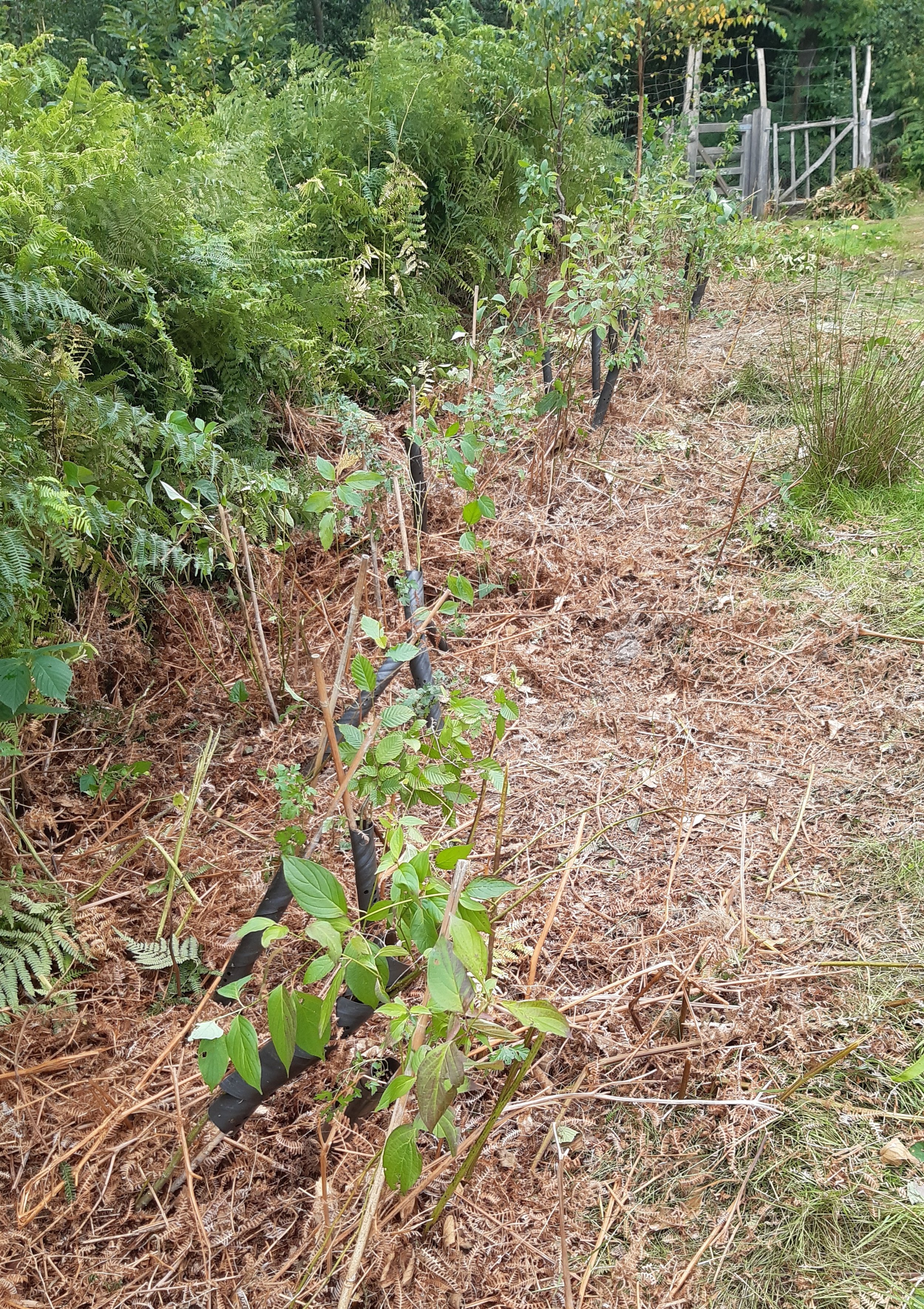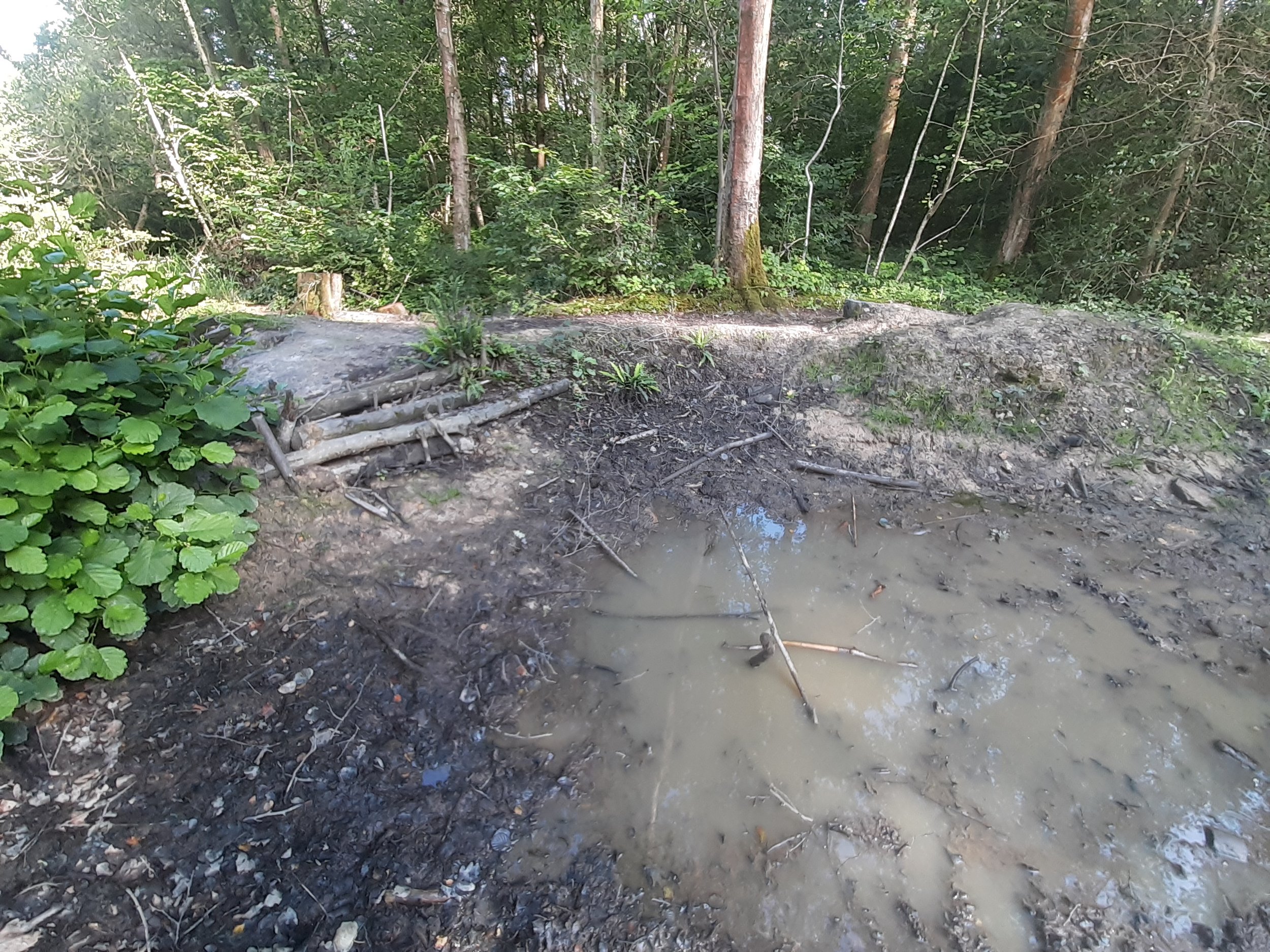Working with Wood Week
Tuesday 25th July – Bracken Bashing
Bracken Carnage at Bat Park
This week the wood is descended upon by scores of members intent upon delivering on a number of wood related projects. For my part I just roll up as a day visitor. I have to spend Tuesday and Thursday leading a group who have dubbed themselves “The Eco-warriors”. When I learn that all but one of them is female I have a vision of marauding Amazons bearing bows and arrows. It turns out that my crowd is a little more diminutive in stature, but nonetheless armed to the teeth with secateurs, loppers, shears and even a scythe.
Our foe today is an invading horde of bracken fronds which have already topped the steep bank surrounding Bat Park and are pouring through the fledgling hedge - planted 4 years ago. The poor hedge shrubs have been over-run, with some of the bracken fronds exceeding 2 metres in height, whilst most of the hedge shrubs are less than 50cm tall. We have just three hours to redress the balance and see how many shrubs we can rescue.
One of the team declares “I like bracken. Why are we pulling it up and cutting it down?”
It's a fair question and answered with a single word - “Biodiversity.”
Some of the most interesting and beneficial of species can be so successful that if they are not controlled we would have nothing else on the planet. They tend to be large plants like bracken, nettle, gorse, blackthorn and others which are able to dominate and choke the life out of smaller flowering plants of meadow and heathland. They all have their place in the world, but not at the expense of everything else.
Before we start our hedgerow rescue I give the group a potted history of Bat Park and the complexity of its management. The space in question was very sickly woodland, potentially suffering from Phytophora fungal attack. After felling the trees, some of it was levelled into a terrace (I think Dan had visions of a tennis court or a bowling green). This level area was sown with a grass and wildflower mix, but the soil was alas so thin that few of the seedlings could cope with being baked by the sun, or washed away by flash floods, whilst those that did grow were cut down by the chomping teeth of rabbits. Fortunately the hedge shrubs had rabbit guards around them.
At one point I did perceive that bracken might be our friend, providing shade for the hedge shrubs and also hiding them from fallow deer which eat anything that grows above rabbit guard height. Rewilders point out the value of areas of scrub acting as nurseries for young trees, so why not bracken likewise?
Conservation is a bit like politics in that you have to form alliances with unlikely partners. I'm still not totally convinced of the wisdom of 'chuming-up' to bracken, but I have noticed that the hedge shrubs hidden in the bracken, though small, are growing better than their counterparts outside of it.
What has happened to change my views of late is the recently completed deer fence around Bat Park. Now we don't need our alliance with bracken any longer and are turning on our former allies. Despicable I know! Nature is red in tooth and claw and we eco-warriors are no different.
So it is that we send Tim (he of the the scythe) to call time on the bracken in the adjacent heathland area, whilst the rest of us hand pull or cut the marauding bracken to see if we can liberate any hedge shrubs. It quickly becomes apparent that we can, as like rescuers pulling survivors from the wreckage caused by an earthquake, we uncover probably 75%-80% of the hedge shrubs planted 4 years earlier. Many are quite meagre specimens, but at least they are alive and given a few years of bracken-free growth should one day form a living mixed hedge of hawthorn, hornbeam, hazel, spindle, guelder rose, wayfaring tree and blackthorn. These species all produce either flowers for insects to feed on, or fruits for the birds and mammals. Bracken lovers can relax though, since we will allow some bracken to hold sway beyond the confines of the hedgerow.
Hedge shrubs ‘pulled out of the wreckage’
In the afternoon I am free to wander the wood and spot wildlife and stumble across a couple of plants which illustrate evolutionary links with large mammals.
Closeup - can you name this flower?
Yes it’s common ragwort
Ragwort is a beautiful flower, but it gets a bad press. Many horse owners are convinced it is poisonous to their animals, but this is assertion comes into question when you consider evolution. Horses have evolved over millions of years, occupying grassland alongside ragwort. They are hardly likely to have evolved successfully if they can't tell a poisonous plant from a non-poisonous one. It is more likely that a few horse deaths might have occurred when horses are kept in pasture with poor grazing. Like a seaman cast adrift in an open boat may be tempted to drink sea water to slake his thirst, so a starving horse might be tempted to eat ragwort as a last resort.
Sallow or goat willow - note that the tip has been nipped off by something
Since we are on the topic of eating plants producing chemicals which may or may not be problematic for animal browsers, see if you can work out why this sallow/goat willow specimen has been singled out for browsing by what I assume to be fallow deer. The answer could well be to do with a chemical found in the leaves of the willow family. Willow leaves contain salicylic acid, the same one used to manufacture aspirin. Perhaps deer suffer from aches and pains too, but have evolved to eat the leaves of sallow/goat willow to their evolutionary advantage – when they have a headache?
Thursday 27th July – New Pond, Repair and Maintenance
At least we have a little more water in the Lower Pond
Our numbers are somewhat depleted today since at least 3 of our number have been requisitioned to cook lunch. So its down to Tim, Leylani and me to sally forth with spades, loppers and the trusty scythe. Down at the New Ponds Tim is despatched to curb the over-vigorous growth of brambles on the island and the line of the proposed access path to the new boardwalk.
Leylani and myself are to move great dollops of subsoil across the unwanted leak in the Lower Pond's retaining embankment. Since subsoil is almost pure clay here it should be possible to dig it, move it to the leak and then tread it. The treading of clay to make it impermeable (water-tight) is known as puddling. The canal builders in centuries past lined the canals with clay whenever the geology beneath was permeable (chalk, sand, limestone). The navvies, their horses and even cattle would be encouraged to walk up and down on the clay to squeeze out any air spaces between the tiny clay particles.
As luck would have it, it rained last night and this morning. This is ideal for filling ponds, but not on the very day you have chosen to shift the clay. Fortunately I have my wellies on, since there must be close to a foot of mud and water in the pond. The rain means we have to wear waterproofs, which is a bit pointless since it means we get wet from the inside-out rather than the outside-in, due to profuse sweating on our part.
As soon as the rain abates a little, off come the waterproofs. We manage to shift 5 or 6 wheel-barrow loads of clay in the ensuing couple of hours and feel encouraged that it should do the job. We still have 30 minutes to attack the mud on the bottom of the pond, which will give us a greater depth of water. Now all we have to do is wait for enough rain to fall to test our repair, otherwise we will need to turn to a mechanical digger to finish the job. Mechanical diggers get the job done quicker, but hand digging ensures a more nuanced and careful approach to the task – especially with regard to the large numbers of diving beetles still populating the almost dry pond of last week. With luck there will be enough water in the pond to see us through to the September or October rains.
In the meantime, Tim and scythe have cut a swath through the brambles and opened up the approach path for the building of a solid trackway down to the proposed boardwalk. Now all we have to do is hope that the funding we are bidding for is forthcoming.
Subsoil material has been moved from the right to the left of the photo to plug the leak
Lower Pond looks more like one - than a puddle - with more rain expected!
Once again I have the afternoon free and come across some interesting plants.
Buddleia or Butterfly Bush
Buddleia was introduced to the UK from China in the 1890s and has since then become naturalised, particularly on waste ground and urban areas. Many species of butterfly are drawn to purple flowers, hence the common name of butterfly bush. Its seeds have wings and are easily dispersed by the wind. Unlike some non-native plants buddleia has a good press and as yet does not cause any major problems for our wildlife.
Birdsfoot Trefoil
Birdsfoot trefoil is a great name, derived from its fruit. These are a collection of tiny peapods which splay out from a central point and look remarkably like the clawed feet of a bird. Personally I prefer the common name of 'eggs and bacon' since I'm partial to a good fry-up in the mornings. The flowers are the colour of an egg yolk, whilst the bacon takes a little longer to cook, appearing when the flower is dying back. Check the photo, especially if you like your bacon on the crispy side.
Jake used to model for Ralph Lauren (Will was a model for Dodos and Kiwis)
When I get to the bottom of the wood I am joined by two of the Wilderness Wood staff who are delivering logs to add to this strange structure. Will (on the left) has built it along with a number of volunteers, including Mia who did the research work and built a scale model of it first. The genius of the design is that not a single screw, nail or bolt holds it together. The builder (and his mate) are confidently demonstrating how solid the whole structure it.
If you would like to follow my exploits walking and cycling the coast of Britain (and other places) then visit https://leggingroundbritain.com/
David Horne











